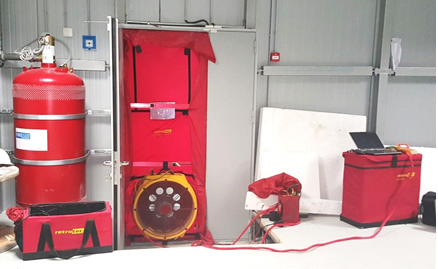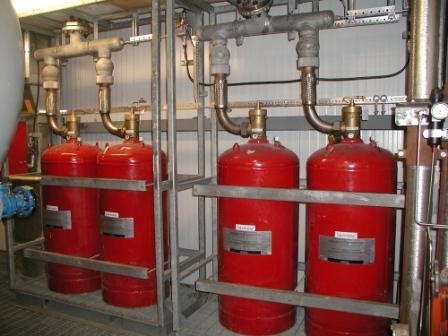Enclosures Integrity tests

In association with our partners from Irbest Ltd. we can accomplish the tests of any complexity.
The Integrity test predicts how long gaseous fire suppressant agents take to descend to a given level in the room without having to release the agent itself.
The Integrity test requires the following equipment:
- Modular adjustable panels for the door frame which adjusts to fit a wide variety of door sizes.
- Calibrated fan(s) configured to the certain flow rate.
- Calibrated gauge(s)
- Portable computer
- Enclosure Integrity Software
Why do we need it?
Water-based suppression systems provide only a minimum amount of fire protection. For critical company information systems, data centers, paper archives, museums and other enclosures whose contents are susceptible to water damage, sprinkler systems will indeed protect the building from fire damage, but at the expense of the contents being protected! It was due to this necessity to provide sufficient fire protection for the building and also to mitigate or eliminate damage to the contents that non-water-based suppression systems were introduced. Halon was one for the first of these fire suppressants. Halon was used for many years and was quite effective, but it was found to be an ozone depleter and had negative health effects. Many Halon alternatives have now been developed. These gaseous systems presented a new problem to the designer however; to extinguish a fire and to keep it suppressed, the gas needed to be present in the enclosure for many minutes. Enclosures now had to be “tight” enough to retain the gas in sufficient concentration and for sufficient time to ensure that re-ignition did not occur.
Both the NFPA and ISO standards recommend that enclosure integrity tests should be carried out to establish the retention time for gaseous agent fire suppression systems. These tests should not only be carried out at the design stage of such systems but also annually thereafter and more frequently if the enclosure integrity may have been compromised by penetrations for pipe work or cabling etc.
Enclosures protected by gaseous fire suppression systems must be airtight in order to maintain concentration and effectively prevent re-ignition. NFPA 2001 Annex C and ISO 14520 Annex E both require a Door Fan (blower door) test to prove that the protected enclosure is tight enough to maintain sufficient concentration. Test results can also be used to predict how much pressure will develop in an enclosure when the gas discharges, to ensure that this pressure will not knock down any walls or blow out any windows.

The typical Blower Door system is comprised of four main parts:
– Door Panel, which temporarily seals a typical doorway and provides a hole to mount a fan.
– Calibrated fan, capable of creating a measurable flow of air.
– Two-channel differential pressure gauge that can also calculate flow for a particular fan.
– Fan speed controller to change the air flow through the fan (can be provided by the gauge).
The specially designed calibrated fan is temporarily mounted in a doorway using the Door Panel. The fan is used to blow air into or out of a room, or building, to measure the air leakage of the protected enclosure. The gauge measures the pressure across the calibrated fan and calculates the flow or other values of interest (such as equivalent leakage area).
The Blower Door Systems measure the amount of air leakage by establishing a pressure difference between the inside and the outside of an enclosure. The pressure difference forces air to leak through all of the holes in the exterior envelope of the enclosure. The amount of air flow that is required to maintain a constant pressure difference is equal to the amount of air that is leaking from the enclosure. A specially designed gauge can thus be used to measure the pressure difference and calculate the amount of air flowing through the calibrated fan, which can then be used to determine the total size of all those leaks.
Once the leakage is quantified, the results are entered into FanTestic Integrity software which calculates how long an acceptable concentration will be maintained (called the hold time) based on formulas in either the NFPA or the ISO standard. The software also makes the calculations to predict how much pressure will develop in an enclosure when the gas discharges, and the required size of additional venting to reduce the overpressure to an acceptable level.
